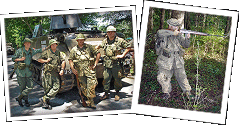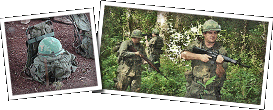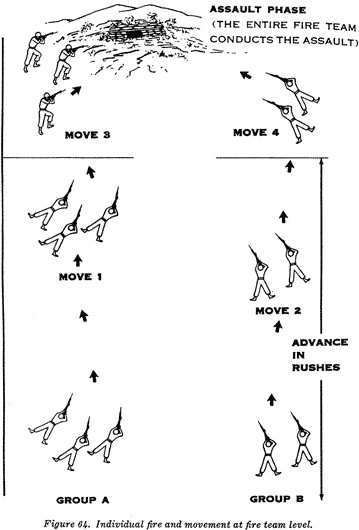Battle Drill
FM 7-15 Rifle Platoon and Squads Infantry, Airborne and Mechanized, March 1965
Excerpts by David S. Stieghan, Illustrations Scanned by Brian Mead
- General
Battle drill is the immediate action drill taken by a squad or platoon to return fire and deploy against the enemy in any situation without issuing lengthy orders. At squad and platoon level, battle drill results in immediate fire and movement or fire and maneuver (para. 26)….
- Squad Teams
- The organization of the rifle squad into two fire teams provides the
squad leader with two elements to execute fire and maneuver. Essentially,
one fire team is the maneuver element, while the other is the fire support
element. The role of each fire team may change during the conduct
of any particular action. For example, if the maneuver element is
prevented by enemy action or terrain from closing with the enemy, it assumes
the fire support role to cover the advance of the other team, which becomes
the maneuver element.
- Although the rifle squad is organized into teams, this organization does not prevent the squad leader from altering the organization of his maneuver and fire support elements to conform to a specific situation. When the terrain offers excellent firing positions and more firepower is required in the fire support element than can be provided by one team, the squad leader may designate both automatic weapons, one or two grenadiers, and one of the fire team leaders to act as the fire support element, with the remainder of the squad acting as the maneuver element. However, such a subdivision of the squad takes time to accomplish and loses some of the squad’s precision and interchangeability of fire teams.
- Fire Support Element
- The fire support element assists the maneuver element in its advance
toward the enemy position by engaging all known or suspected targets. It
continues its fire until masked by the maneuver element (fig.
62).

- This element is aggressive in its action. While delivering fire on the enemy, if necessary, it continues to move closer to a more favorable firing position without losing continuous fire support. When the maneuver element masks its fires, the fire support element moves forward to assist in consolidation.
- Maneuver Element
- The mission of the maneuver is to close with and destroy or capture the enemy. It advances and assaults under the close fires of the fire support element.
- The maneuver element’s principal job is to maintain the advance toward the enemy. It uses available cover and concealment to the maximum, creeping and crawling when necessary. Depending upon the terrain and effectiveness of the supporting fire, the maneuver element advances by fire team movement, fire and movement within the team, or creeping or crawling. Regardless of how it moves, it must continue to advance. If terrain permits, the maneuver element may be able to move forward, under cover and concealment, to positions within hand-grenade range of the enemy (fig. 62).
- Control of the Squad
- The squad leader is assisted in the control of the squad by the two fire team leaders. The organization of the squad into two fire teams in no way prevents the squad leader from directly controlling individual squad members. The squad and fire team leaders display positive and forceful leadership when executing battle drill.
- The squad leader gives the necessary command or signal to execute the desired battle drill action. Fire team leaders initiate the action directed by the squad leader. If necessary, they repeat the command signal. Fire team leaders act as fighter-leaders, controlling their fire teams primarily by example. Fire team members base their actions on their fire team leader. Throughout the action, fire team leaders exercise such positive control as is necessary to insure that their fire teams function as directed. The squad leader located himself where he can best control and influence the action. Normally, he will move with the maneuver element.
- In a situation in which the squad is brought under effective small-arms fire while advancing, certain actions are automatic. Those in position to return fire do so immediately. Members of the leading fire team move by individual rushes, or by creeping and crawling, to take advantage of all available of all available cover provided by the terrain and supporting fire. They move to positions generally abreast of their fire team leader and attempt to gain fire superiority over the enemy (fig. 63). The squad leader quickly makes an estimate of the situation, decides his course of action, and signals his plan. His plan provides for gaining fire superiority (fig. 64) before entering the assault phase, and may include the following:
- Squad Battle Drill
- Squad battle drill includes squad fire and movement and squad fire and maneuver (maneuver left, maneuver right, and maneuver front). These maneuvers are executed from the squad formation.
- The maneuver used in a particular situation is decided by the squad leader, based on his rapid estimate of the situation. He quickly considers such factors as the terrain (covered and concealed routes available for maneuver, and positions available for fire support), enemy dispositions and capabilities, his own dispositions, and the courses of action open to him. When the resistance is isolated and has exposed flanks, the squad leader attempts to move his maneuver element over a covered and concealed route to strike the enemy resistance in the flank or rear. When this is not possible, a frontal attack requiring fire and movement may be required.
- Battle Drill from Squad Column (Fire Teams in Column)
To execute maneuver right, maneuver left, or maneuver to the front, the squad leader gives the appropriate command and signal, and the squad executes a maneuver similar to that in figures 65 (maneuver right or left) and 66.
- Battle Drill from Squad Column (Fire Teams Abreast)
To execute maneuver right, maneuver left, or maneuver to the front, the squad leader gives the appropriate command and signal, and the squad executes a maneuver similar to that in figures 65 (maneuver right or left) and 68.
- Battle Drill from Other Squad Formation
- Battle drill can be executed from the squad line formation in a manner similar to that depicted in maneuver front (fig. 66). The action executed will usually be fire and maneuver, since disengaging a fire team to maneuver to either flank will normally be very difficult.
- Platoon Battle Drill
The platoon employs battle drill when it encounters unexpected enemy resistance. There are three basic maneuvers: maneuver left, maneuver right, and maneuver front. These maneuvers can be executed from any of the platoon formations. In addition, the rifle platoon may employ fire and maneuver from the line formation at squad, or team, or individual level, depending on the effectiveness of the enemy’s fire from the objective area.
- Maneuver Left or Right. To execute maneuver left or right, the platoon leader commands and signals, “MANEUVER LEFT (RIGHT),” and the platoon maneuvers as shown in figures 69, 70, and 71.
- Maneuver Front. To execute maneuver front, the platoon leader commands “PLATOON LINE,” and the platoon executes the maneuver as shown in figure 72. The maneuver element in this case normally employs fire and movement.
- Rifle Squads
The rifle squad leaders, upon receiving a signal or order from the platoon leader, control their squads by signaling and commanding “CHANGE DIRECTION,” or “FOLLOW ME,” and set the example by moving in the desired direction. The squads move in formation under cover, or by fire and maneuver, until they are able to take the enemy under effective fire. Here, they either form an assault line under supporting fires or execute squad battle drill.
- Weapons Squad and Attached Crew-Served Weapons
The platoon leader must issue a fragmentary order to the platoon sergeant and weapons squad leader in order to most efficiently employ the organic and attached crew-served weapons. Normally, attached crew-served weapons are employed with the weapons squad. The platoon sergeant usually remains with the fire support element.
[Mechanized Drill follows, omitted]












